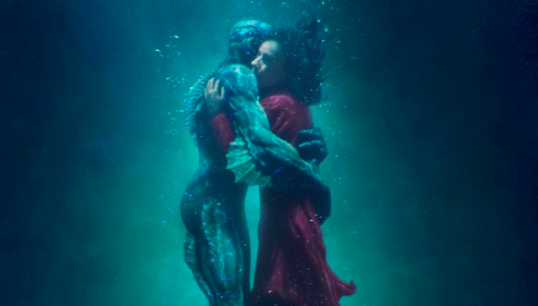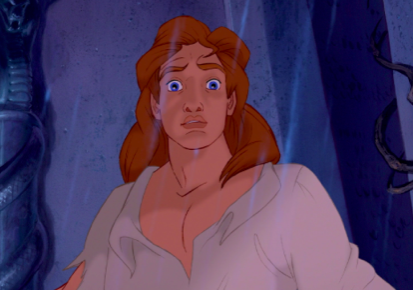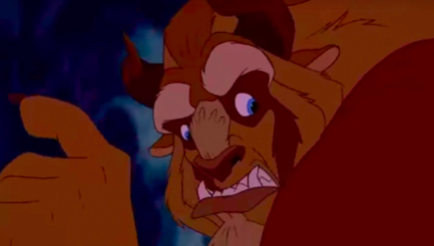Alissa Wilkinson, of Vox, called last year’s Oscar winner, “an allegorical film about embracing the other.” E. Oliver Whitney of ScreenCrush said the film’s characters “transcend barriers and prejudices to find strength, love, and connection.” And Kenneth Turan, of The LA Times, said the movie had “moral overtones.” They were talking, of course, about The Shape of Water, a film in which a woman has sex with a fish monster.

The monster romance narrative isn’t new. In fact, you might even call it a tale as old as time (ha ha). But what is new is the feminist acceptance — even adulation — of it. Look at the way feminists discuss Beauty and the Beast. Thelma Adams, of The Observer, said the story of Beauty and the Beast was about “bestiality,” plain and simple. Jia Tolentino wrote a piece in The New Yorker called “Beauty and the Bestiality” in which she points out that Belle’s “man was a bison.” And Anna Klassen, of Bustle, says “The idea of a woman falling in love with a talking animal” is “dark.” Just so we’re clear: for feminists, The Shape of Water is a work of genius, but Beauty and the Beast is really gross.
Turan calls The Shape of Water a “fairy tale.” So does Wilkinson. So does Guy Lodge of Variety. So do lots and lots of other film critics and bloggers on the internet. But what makes this “fairy tale” about a girl falling in love with a monster, so much better than the actual fairy tale about a girl falling in love with a monster? How is this one an “allegory” and the other one “bestiality”? It’s simple really: feminists don’t get fairy tales.
Here’s the problem: the Beast in Beauty and the Beast is actually a man, Amphibian Man is not. The allegory of the monster romance narrative in a fairy tale comes from the fact that the beast form is symbolic. The man becomes a beast because he has let his base male urges run unchecked such that he is like (though not actually) an animal. So he takes on an animal form to represent that. The arc of his narrative is to find a way to channel those urges and instincts. When he does, this is represented by the restoration of is human form. The woman in the story sees past the beastly exterior to the man within. She responds to him as a man and this allows him to change back into one. She is attracted to what his beast form represents — his raw masculinity — but not his beast form itself. (For more on the symbolism of Beauty and the Beast click here, and here.)

Amphibian Man, from The Shape of Water, on the other hand was never a man. The whole point of him is that he is “other.” His monster form doesn’t represent anything, he really is a monster. His human lover, Elisa, doesn’t see the man within the beast (there is no man!), she just sees the beast — and she wants to have sex with it. But this, we’re supposed to all rapturously agree, is not bestiality (like that awful Beauty and the Beast story), this is the “allegory.” But, an allegory of what? (Excuse me while I go scream into a pillow.)
Guillermo del Toro, who directed and wrote The Shape of Water, said he was influenced by the1954 monster movie Creature from the Black Lagoon. Turan relates that del Toro wondered why the creature never got the girl. Turan chimes in: “Why, indeed.” But the answer to that is simple: Creature from the Black Lagoon was not a fairy tale. It was a monster movie. There’s a big difference.
In a monster movie the monster was never a man. Films like Creature from the Black Lagoon or King Kong, for example, feature the unrequited love of a monster for a human woman. This makes sense. Women aren’t attracted to monsters! They can become attracted to the man they see beyond the monstrous exterior. But only if there is one. In a monster movie (as opposed to a fairy tale) there is no man. A monster who is somewhat human-like might yearn for humanity (even though he can never achieve it), and that might cause him to fall for a human girl. But the attraction doesn’t go both ways. It can’t. And if we feel sorry for the monster — which we might — it’s because of his lack of humanity, not because we wish the girl would just forget that he’s not human and get with him anyway.

But in The Shape of Water that’s exactly what she does. The thing that feminists think is so wonderful about The Shape of Water is the very fact that Amphibian Man isn’t actually a man. How wonderful that the ugly creature doesn’t have to turn into a handsome prince in order for the woman to want to sleep with him! It’s so accepting! So moral! So adult! It’s so wonderfully radical that the movie goes into detail about Amphibian Man’s genitals and how they work and that no one in the film is grossed out by this. (I’m grossed out by this!) But Beauty and the Beast is about a woman who falls in love with an animal, and that’s disgusting. Feminists want to remove all the symbolism from the fairy tale, and place it somehow on the monster movie. But that doesn’t work. It cant.
What if the Beast was really a beast? What if, instead of being a man under a spell, he was actually born a sort of part buffalo, part lion, part bear creature? What if he didn’t talk — and never could? What if he wasn’t really interested in becoming human? Would we still want Belle to fall in love with him? To marry him? To have sex with him? (Please, for the love of God, say no!)

And yet, for feminists, a woman falling in love with a man whose base masculinity is allegorically represented as a beast is bestiality. But a woman falling in love with an actual beast — that’s romantic. That’s the allegory. (What?!)
The fact that Elisa turns out to perhaps also be some sort of aquatic creature doesn’t actually change any of this. It just makes the whole thing more confusing. Because, if she really is the same species as Aquatic Man, then none of the “barrier breaking” feminist wonderfulness of it all still applies. And if she isn’t, then she just had a bunch of sex with a fish.
The real problem is this: feminists don’t understand fairy tales. So they rip them apart, and put their elements back together in ways that don’t make any sense and call it progress. It isn’t progress. It’s sloppy. (And frankly kind of gross.) Read some fairy tales. Then read a book about fairy tales. Then read some more fairy tales. Then tell me what you think.
I skipped watching the Shape of Water. Now I think I’ll just rewatch Beauty and the Beast instead.
LikeLiked by 2 people
Yes, that seems wise.
LikeLiked by 1 person
Hi Faith! I wrote a bit on reddit along similar lines:
LikeLiked by 2 people
I like it!
LikeLike
Fully agreed with you, both regarding just how bad of a comparison Shape of Water was and how feminism ruins fairy tales (though I’d personally argue that Feminism already ruined the Disney version of Beauty and the Beast, especially after Linda Woolverton and Don Hahn openly bragged about pushing that agenda in the film and it basically treating marriage in a negative light, to the extent that the closest to foils Belle had just came across as airheads thanks to being the only females in the film who actually did support marriage, not even close to malicious at all despite what the narrative claimed.). Heck, forget Beauty and the Beast, Shape of Water’s not even CLOSE to comparable to The Little Mermaid. That movie and even the original story (the latter of which I utterly hated) at least had Ariel TRYING to become a human, and while unable to use her voice box still managed to communicate. And personally, I’m not fond of GDT for his bashing America and claiming Mexico was better despite leaving that country, his Marxist politics, as well as his defending that jerk Hideo Kojima despite the latter ruining the Metal Gear series in more than one way. I only liked two of his movies, both of which were derived from a series of graphic novels (I’m of course talking about the Hellboy movies).
LikeLiked by 1 person
When you got to the example of King Kong, it reminded me of the new Wreck-It Ralph movie. While I enjoyed the movie I found it troubling in a way I find hard to define. Perhaps part of it is this conflation of man with beast. I’m still not sure. I’d love to hear your take on it.
LikeLiked by 1 person
Interesting! I haven’t actually seen the film. I was really annoyed with their portrayal of Disney princesses though.
LikeLike
My wife and I also found “Wreckit 2″depressing. I found this post which hit the nail on the head IMO:
It’s a “buddy” picture where a super cute, sharp as a tack girl is teamed with a dumb as a brick toxic male. Ralph demeans and humiliates himself publicly in order to save Vanellope and the rest of the characters in her game. He accomplishes that but she leaves him to move to a version of “Grand Theft Auto V” run by an alpha female and in the end he gets little or no credit for it. He “wrecks the internet” in a vain effort to keep her out of an adult game. In the finale, Ralph learns his life lesson not to control his female friends and goes back to his therapy sessions with the other “bad guy” characters while Vanellope is joyously racing in the video game gangsta ghetto world with her new gangsta girl pal. Extra credit for having his life saved from his own foolishness by a full complement of the Disney Princesses who are now cynical tough girl super heros.
LikeLiked by 1 person
Wow, that’s really awful.
LikeLike
“The real problem is this: feminists don’t understand fairy tales. So they rip them apart and put their elements back together in ways that don’t make any sense and call it progress. It isn’t progress. It’s sloppy.”
Yes, yes, and yes! This is a brilliant post, Faith, really. 2 thumbs up from me.
LikeLiked by 1 person
Thank you!!
LikeLike
“[F]eminists don’t understand fairy tales,” nor do they seem capable of enjoying anything.
LikeLiked by 1 person
i condone you for your bravery in writing this post! really! nowadays it seems like no one can speak against the so-called “feminists” that they and social justice warriors are ready to jump at you! i totally agree with your arguments. I just watched the movie and i found all of it very disturbing.. I mean.. how can feminists romanticize this movie at all? right from the start is full of weird sexual scenes in which the poor woman is objectified. I really saw no point in showing her orgasms and all those boobs etc.. I suppose feminists would claim she is sexually in control or some bs but for me it was just another utter objectification of the female body. To me it felt like the director was trying to portray her sort of “sexual frustration,” which also derives from being an outcast. Like.. do we really need to see that to understand that she is lonely in this society? I am not sure…
Btw, if you like movies and Harry Potter I have started my own blog 🙂 check it out if you’d like https://franoculars.home.blog/
LikeLiked by 1 person
Thanks so much! You’ve definitely come to the right place if you’re looking for critiques of the “feminist” narratives on pop culture.
LikeLiked by 1 person
unfortunately our media is saturated with these people pushing forward what they think are politics of equality
LikeLiked by 1 person
I hope you’ll ready my book! https://www.amazon.com/Saving-Cinderella-Feminists-Disney-Princesses/dp/1790657563/ref=sr_1_1?ie=UTF8&qid=1549894581&sr=8-1&keywords=saving+cinderella
That’s part of the thesis.
LikeLike
Really? You think feminists are ruining fairy tales? They’re the ones who’ve exposed the original fairy tales as violent, ageist and sexist. Remember when the dwarves forced the evil queen who poisoned Snow White into some red-hot metal shoes and forced her to dance to death? That was in the original fairy tale. Remember when the step-sisters had to cut off their feet to fit into Cinderella’s glass slipper? That was also in the original fairy tale. Or how about when the prince had sex with Sleeping Beauty while she was sleeping? That also was in the original fairy tale. Remember when Scherazade had to keep the Sultan from killing her with a story every night because he had a tendancy to marry and kill women he thought were unfaithful? That is the framing story of the Arabian Nights. And how do you know those writers are feminists? VOX and The L.A. Times are notorious for smearing any feminist that rejects transgender ideology as TERFs and transphobes. Now I agree that The Shape of Water is trash but don’t place the blame of it’s curious success on feminists. Men have been just as guilty (maybe more than women because Toro has a strong male fanbase) of praising this crappy film and here are some articles written by women and one man) that criticize the film:
https://www.inverse.com/article/41056-shape-of-water-disturbing-trend-cat-death
https://www.baltimoremagazine.com/section/artsentertainment/review-the-shape-of-water/
https://www.gamespot.com/articles/the-shape-of-water-review-the-problem-with-inter-s/1100-6455107/
https://www.popmatters.com/tiff-2017-the-shape-of-water-guillermo-del-toro-2495378263.html
LikeLike